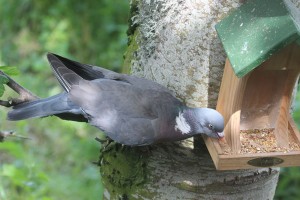 One of the features of the beginning of the New Year has been the “song” of the woodpigeons from gardens, woodland and taller hedges. The call notes are almost a restful sounding “cooing” notes that vary so that each bird may sound slightly different. The song is that more conspicuous because at this time of the year very few other birds are singing. One other exception is the winter song of the robin. The song of the woodpigeon indicates a very interesting feature as it is one of the very few birds that can be found breeding throughout every month of the year. This depends to a certain extent on the weather as records show that the main breeding season is between July and September.
One of the features of the beginning of the New Year has been the “song” of the woodpigeons from gardens, woodland and taller hedges. The call notes are almost a restful sounding “cooing” notes that vary so that each bird may sound slightly different. The song is that more conspicuous because at this time of the year very few other birds are singing. One other exception is the winter song of the robin. The song of the woodpigeon indicates a very interesting feature as it is one of the very few birds that can be found breeding throughout every month of the year. This depends to a certain extent on the weather as records show that the main breeding season is between July and September.
The woodpigeon only lays two eggs but this is compensated for by the fact that they may bring off three broods each year. The nest is, perhaps, the flimsiest of any nest as it is merely a thin platform of twigs in a tree. However, despite this flimsy structure, it is often used for all of the broods each year. The eggs are white and such is the structure of the nest that they can sometimes be seen from below. Both the adults take it in turn to incubate the eggs that take around 17 days to hatch. Both parents also feed the young that are often known as “squabs” and they are fed on “crop milk” formed, as the name suggests, in the crop of the adult. The squabs fly after a round 33/34 days but it may be longer if the nest is disturbed very often.
The woodpigeon has long been considered a serious agricultural pest and at one time the government paid a subsidy on cartridges to shoot them. Organised shoots were part of country life but despite this the numbers of woodpigeons never seemed to change very much. Using telescopic aluminium poles for poking out nests was also very much in the vogue but here again they never seemed to have much effect on numbers of the birds. One spin-off from all the shooting was the fact that the woodpigeon is delicious to eat and, after the rabbit, was perhaps the commonest dish on the plates of many country folk. As for the numbers, the problem is that unless everyone in the countryside shoots the birds they will have little effect. The birds just continue to multiply in areas where they are relatively undisturbed. The numbers and damage is not surprising when you consider that there are 600,000 pairs breeding in Scotland each year. There is also the surprising fact that no less than 1.5 million woodpigeons over winter and this includes birds from the continent overwintering here.
There are at least nine Scots names with the commonest being “Cushie Doo” and others including “Ring Pigeon” and “Timmer Doo”. Of the two Gaelic names the commonest in use is “Calman-coille” meaning Dove of the wood. One of the quotations from Scottish literature that keeps cropping up is “The Wood pigeon has an odd look in its eye that suggests perpetual astonishment”. You can see the suggestion of this in the photograph I took at a feeder in my garden. The photograph shows a woodpigeon adapting to a new feeder almost as quickly as the small birds. The feed is one of the better, and more expensive, seed mixes designed for finches and other small birds. Typical of the adapted pose of a woodpigeon, the bird is sitting on a small branch pecking at the feeder.
Tags: highland wildlife
